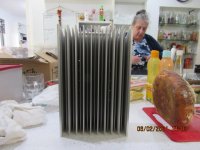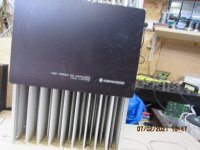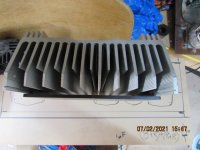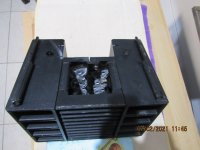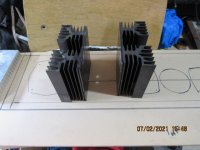Thinking about making an amplifier and while I have a collection of heat sinks here the biggest are from 200W amps and I may need something much larger.
If I was to assemble a heatsink from bits and pieces I have around is there a design calculator that is usable for vertical tunnels as I have read that vertical tunnels are more efficient than horizontally finned ones.
Is this true?
I have the large heat sink in the pictures attached but running the calculator over at Rod Elliots sound pages I get a figure of approximately 0.14C per watt which might be marginal for the power I want and need.
I want 300 watts and stereo so I would need to dissipate 600 watts from the single heat sink.
I had an idea to fit this amplifier into an old computer case I have in the shed
If I was to assemble a heatsink from bits and pieces I have around is there a design calculator that is usable for vertical tunnels as I have read that vertical tunnels are more efficient than horizontally finned ones.
Is this true?
I have the large heat sink in the pictures attached but running the calculator over at Rod Elliots sound pages I get a figure of approximately 0.14C per watt which might be marginal for the power I want and need.
I want 300 watts and stereo so I would need to dissipate 600 watts from the single heat sink.
I had an idea to fit this amplifier into an old computer case I have in the shed
Attachments
Moondog55,
I recall you discussing the heat-sinks in another thread - are you planning to build this project (high power version):
https://www.diyaudio.com/forums/solid-state/367387-newbie-question-re-heat-sinks.html#post6520188
Project 101 - High Fidelity Lateral MOSFET power amplifier
I recall you discussing the heat-sinks in another thread - are you planning to build this project (high power version):
https://www.diyaudio.com/forums/solid-state/367387-newbie-question-re-heat-sinks.html#post6520188
Project 101 - High Fidelity Lateral MOSFET power amplifier
Last edited:
Yes my query pertains to that thread.
Although if Mr Elliott brings in a bigger version I'd be happy with a bigger version. I build heat exchangers and stack robbers for wood stoves [ another passion is winter camping and ski touring] and think I can easily assemble something large enough.
Because I build speakers people are often giving me old gear and I have collected a lot of heat sinks that way
Although if Mr Elliott brings in a bigger version I'd be happy with a bigger version. I build heat exchangers and stack robbers for wood stoves [ another passion is winter camping and ski touring] and think I can easily assemble something large enough.
Because I build speakers people are often giving me old gear and I have collected a lot of heat sinks that way
Just now I found out that the front panel from my deceased Kenwood is a friction fit inside the finned section of that tall heat sink. The other heat sinks are from an old but very powerful Inkell amp
Attachments
If it's the amp I found on his sight I think he said 240W was as large as he recommended building it. And then it needed a .4 c /watt heat sink. With the exception of a class A amp a 300 watt amp does not dissipate anything neat 300w.
Into 8R yes I know but no mention that I can see about into 4R.
Where does he give that 0.4C per watt information?
OK Sorry I found it in the first paragraph
Hence my query about tall chimney heat sinks being more efficient as I think I can convert the one I have into a chimney and add fan cooling too, heaps of small quiet computer fans here both 240V and 12V
Where does he give that 0.4C per watt information?
OK Sorry I found it in the first paragraph
Hence my query about tall chimney heat sinks being more efficient as I think I can convert the one I have into a chimney and add fan cooling too, heaps of small quiet computer fans here both 240V and 12V
Last edited:
Also I may be confusing the project 68 and the project 101, it's the P-68 subwoofer amp rated that high
- Home
- Design & Build
- Parts
- Heat sinks query? Design there-off
